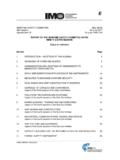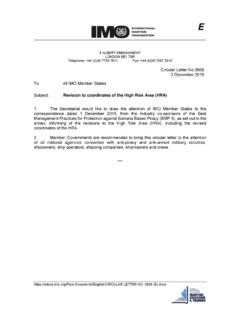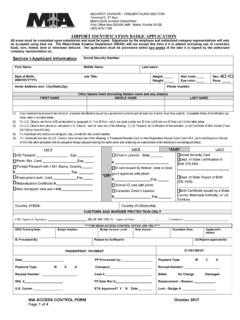Transcription of Best Management Practices for Protection against ... - Piracy
1 WORLD SHIPPING COUNCILP A R T N E R S I N T R A D EInterManagerBest Management Practices for Protection against Somalia Based PiracyiBMP4 best Management Practices for Protection against Somalia Based Piracy (Version 4 August 2011)Suggested Planning and Operational Practices for Ship Operators and Masters of Ships Transiting the High Risk AreaiiTerms of UseThe advice and information given in this booklet ( Booklet ) is intended purely as guidance to be used at the user s own risk. No warranties or representations are given nor is any duty of care or responsibility accepted by the Authors, their membership or employees of any person, firm, corporation or organisation (who or which has been in any way concerned with the furnishing of information or data, the compilation or any translation, publishing, supply of the Booklet) for the accuracy of any information or advice given in the Booklet or any omission from the Booklet or for any consequence whatsoever resulting directly or indirectly from compliance with, adoption of or reliance on guidance contained in the Booklet even if caused by a failure to exercise reasonable care on the part of any of the aforementioned August 2011 ISBN.
2 978 1 85609 505 1 WITHERBYPUBLISHING GROUPS ince - 1740 AINP ublished in 2011 byWitherby Publishing Group Ltd4 Dunlop SquareLivingston, Edinburgh, EH54 8 SBScotland, UKTel No: +44 (0) 1506 463 227 Fax No: +44 (0) 1506 468 999 Email: Three Fundamental Requirements of BMP vSection 1 Introduction 1 Section 2 Somali Pirate Activity The High Risk Area 3 Section 3 Risk Assessment 5 Section 4 Typical Pirate Attacks 9 Section 5 BMP Reporting Procedures 11 Section 6 Company Planning 13 Section 7 Ship Master s Planning 17 Section 8 Ship Protection Measures 23 Section 9 Pirate Attack 41 Section 10 If the Pirates take Control 45 Section 11 In the Event of Military Action 47 Section 12 Post Incident Reporting 49 Section 13 Updating best Management Practices 51 ANNEX A Useful Contact Details 53 ANNEX B UKMTO Vessel Position Reporting Forms 55ivANNEX C Piracy Definitions 57 ANNEX D Follow-up Report 61 ANNEX E MSCHOA Vessel Movement Registration Form 64 ANNEX F Additional Guidance for Vessels Engaged In Fishing 68 ANNEX G Additional Advice for Leisure Craft Including Yachts 71 ANNEX
3 H Supporting Organisations 72vThe Three Fundamental Requirements of BMPR egister at MSCHOA Report to UKMTO Implement SPMs1. Register at MSCHOA Ensure that a Vessel Movement Registration Form has been submitted to MSCHOA prior to entering the High Risk Area (an area bounded by Suez and the Strait of Hormuz to the North, 10 S and 78 E). This may be done directly online by the Ship s Operator, by fax, or by email. (See Annex E for details of the MSCHOA Vessel Movement Registration Form).All vessel movements should be registered with MSCHOA even if the vessel is transiting as part of a National Convoy, there is a security team onboard or if not transiting the Gulf of Aden. 2. Report to UKMTOOn entering the UKMTO Voluntary Reporting Area an area bounded by Suez to the North, 10 S and 78 E - ensure that a UKMTO Vessel Position Reporting Form - Initial Report is sent (see Annex B).
4 Vessels are strongly encouraged to report daily to the UKMTO by email at 08:00 hours GMT whilst operating within the High Risk Area. The UKMTO Vessel Position Reporting Form - Daily Position Report (as set out in Annex B) should be used. UKMTO acts as the primary point of contact for merchant vessels and liaison with military forces in the region and it is the primary point of contact during an attack. For this reason they should be aware that the vessel is transiting the High Risk Implement SPMsThe Ship Protection Measures described in BMP are the most basic that are likely to be effective. Owners may wish to consider making alterations to the vessel beyond the scope of this booklet, and/or provide additional equipment and/or manpower as a means of further reducing the risk of Piracy attack. If pirates are unable to board a ship they cannot hijack The purpose of the Industry best Management Practices (BMP) contained in this booklet is to assist ships to avoid, deter or delay Piracy attacks in the High Risk Area, as defined in section 2 (see Page 4).
5 Experience and data collected by Naval/Military forces, shows that the application of the recommendations contained within this booklet can and will make a significant difference in preventing a ship becoming a victim of The potential consequences of not following BMP, as set out in this booklet, are severe. There have been instances of pirates subjecting their hostages to violence and other ill treatment. The average length of a hijacking of vessel and her crew is over 7 months. (Note Naval/Military forces often refer to a pirated vessel rather than a hijacked vessel, but the meaning is the same). For the purposes of the BMP the term Piracy includes all acts of violence against ships, her crew and cargo. This includes armed robbery and attempts to board and take control of the ship, wherever this may take place. Somali pirates have, to date, sought to hijack a vessel, her cargo and crew and hold them until a ransom demand is Where possible, this booklet should be read with reference to the Maritime Security Centre Horn of Africa ( ), and the NATO Shipping Centre, ( ), websites which provide additional regularly updated advice (including up to date alerts on Piracy attacks).
6 Not all Ship Protection Measures discussed in BMP4 may be applicable to every ship type. IntroductionSection 1 Aide This BMP4 booklet updates the guidance contained within the 3rd edition of the best Management Practice document published in June This booklet complements Piracy guidance provided in the latest IMO MSC Circulars, see the IMO website at Nothing in this booklet detracts from the Master s overriding authority to protect his crew, ship and cargo. 3 Somali Pirate Activity The High Risk AreaSection The presence of Naval/Military forces in the Gulf of Aden, concentrated on the Internationally Recommended Transit Corridor (IRTC), has significantly reduced the incidence of Piracy attack in this area. With Naval/Military forces concentrated in this area, Somali pirate activity has been forced out into the Arabian Sea and beyond.
7 It is important to note, however, that there remains a serious and continuing threat from Piracy in the Gulf of Somali based pirate attacks have taken place throughout the Gulf of Aden, Arabian Sea and Northern Indian Ocean, affecting all shipping in the region. The recent increasing use of hijacked merchant ships, fishing vessels and dhows as Motherships enables pirates to operate at extreme range from Somalia, carrying attack craft (skiffs) and Pirate Activity: The level of pirate activity varies within the High Risk Area due to changing weather conditions and activity by Naval/Military forces. Pirate activity generally reduces in areas affected by the South West monsoon, and increases in the period following the monsoon. The onset of the North East monsoon generally has a lesser effect on Piracy activity than the South West monsoon.
8 When Piracy activity is reduced in one area of the High Risk Area it is likely to increase in another area (eg the area off Kenya and Tanzania, the Gulf of Aden and Bab al-Mandeb all generally experience an increase in pirate activity during the South West monsoon). The High Risk Area defines itself by where pirate activity and/or attacks have taken place. For the purpose of BMP the High Risk Area is an area bounded by Suez and the Strait of Hormuz to the North, 10 S and 78 E. (Note - the UKMTO Voluntary Reporting Area is slightly larger as it includes the Arabian Gulf). Attacks have taken place at most extremities of the High Risk Area. Attacks to the South have extended into the Mozambique Channel. A high state of readiness and vigilance should be maintained even to the South of the Southerly limit of the High Risk It is important that the latest information on the location of where pirates are operating is used when planning routes through the High Risk Area.
9 It is also important that vessels are prepared to alter course at short notice to avoid pirate activity when information is provided by NAV WARNINGS and/or Naval/Military forces. Weather can also constitute an obstacle to pirates and can be considered a factor when planning a route through the High Risk Area. It is recommended that the latest advice/updates be obtained from MSCHOA, NATO Shipping Centre, and the UKMTO on the extent and latest location of pirate activity. (See contact details at Annex A). It is strongly recommended that BMP is applied throughout the High Risk AssessmentSection Prior to transiting the High Risk Area, ship operators and Masters should carry out a thorough Risk Assessment to assess the likelihood and consequences of Piracy attacks to the vessel, based on the latest available information (see Annex A for useful contacts, including MSCHOA, NATO Shipping Centre, UKMTO and MARLO).
10 The output of this Risk Assessment should identify measures for prevention, mitigation and recovery, which will mean combining statutory regulations with supplementary measures to combat Piracy . It is important that the Risk Assessment is ship and voyage specific, and not generic. Factors to be considered in the Risk Assessment should include, but may not be limited to, the following: Crew Safety: The primary consideration should be to ensure the safety of the crew. Care should be taken, when formulating measures to prevent illegal boarding and external access to the accommodation, that crew members will not be trapped inside and should be able to escape in the event of another type of emergency, such as, for example fire. Careful consideration should be given to the location of a Safe Muster Point or Citadel. (See section ).





